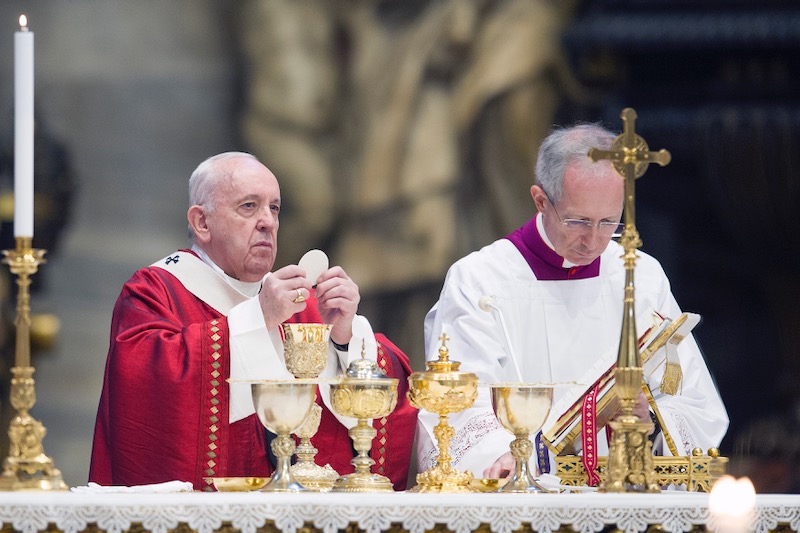Just two words – but they say everything about the direction of the reforms of the Francis era.
The words are contained in the new Italian translation of the Mass texts, approved by Pope Francis, and will be used from Easter Sunday 2021.
In the prayers said over the bread and wine, the priest says – as he always has – that Jesus’ blood was poured out per tutti (“for all”) and not per molti (“for many”).
The Italian bishops have, in reality, changed nothing, simply keeping the translation of the Latin phrase pro multis that has been widely used since the liturgical reforms mandated by the 1962-65 Second Vatican Council.
But that is what is so significant. The translation of pro multis has been the subject of intense debate over recent decades.
Following the Council, many countries used the equivalent of “for all” in their translations, although this began to change in 2001, after the Liturgiam Authenticam instruction called for a more literal translation of Latin texts.
In 2006, Rome ruled that pro multis should be translated as “for many” with Benedict XVI insistent on this point.
In the translations of the Roman Missal used in English, Spanish and French-speaking countries, the equivalent of “for many” is used. Yet despite Rome’s insistence, in 2011, the Italian bishops resisted and voted overwhelmingly to keep “for all”. And that’s how it is in the newly-printed Italian Missals.
At the heart of the debate is an important theological question.
“For all” reflects the truth that Christ died for everyone, while “for many” reflects the truth that salvation requires the participation of individuals. Matthew 26:28 and Mark 14:24 both refer to Christ’s blood being shed “for many”.
The consistent theme of the Francis pontificate is that God’s mercy is all-embracing, and the Church is a field hospital welcoming all sinners. No one is excluded. Although a less literal translation of the Latin, the phrase “for all” better reflects the teaching that Christ’s sacrifice was for the whole of humanity, and is in keeping with Vatican II.
As the old Latin motto explains: lex orandi, lex credendi. The rule of prayer is the rule of belief.
On 28 August, in the Vatican’s apostolic library, the Pope was presented with a copy of the translation of the Roman Missal into Italian by a delegation of male and female liturgical experts led by Cardinal Gualtiero Bassetti, the president of Italy’s bishops’ conference.
Bishop Claudio Maniago, who has responsibility for liturgy in the Italian hierarchy, said the Pope told the delegation that liturgical books must demonstrate the conciliar reforms.
Since the council, which allowed the use of vernacular languages in the liturgy, bishops across the world have been tasked with translating the Latin texts. And over the years, they’ve been required to update their translations. Under the papacies of John Paul II and Benedict, Rome sought to centralise the process.
This brings us to the next big shift during the Francis pontificate, which is not just about the words but the way the translations are approved.
In 2017, the Pope gave greater powers to local bishops’ conferences over how Latin liturgical texts are to be rendered in the vernacular.
Magnum Principium removed the requirement that Rome authorise every aspect of translations; instead, its role is to review translations that have been commissioned and approved by the bishops’ conference. Crucially, it aligned the Church more closer with the vision of the Second Vatican Council, which had paved the way for local bishops to have more authority. A healthy decentralisation is key element of the Pope’s reforms.
“Excessive centralisation”, Francis wrote in his “manifesto” document, Evangelii Gaudium, “complicates the Church's life and her missionary outreach.” In other words: when it comes to the wordings of prayers, it is the bishops on the ground, not curial officials in Rome, who are the best judges of what is going to most effectively aid evangelisation.
The Italian missal drama shows the step-by-step reforms of the Francis papacy are all about implementing Vatican II, the most significant ecclesial event in the last 60 years which laid the foundation stones for the Church of the Third Millennium.
For more on this story, check out Christopher Lamb's View from Rome https://www.thetablet.co.



 Loading ...
Loading ...